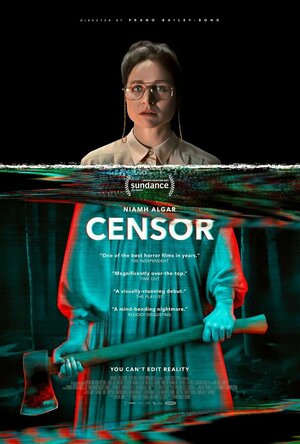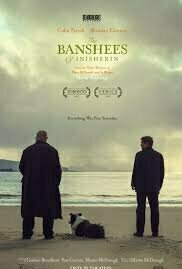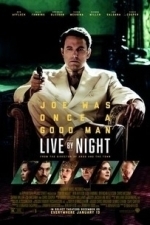
HelloTalk Language Exchange
Education and Social Networking
App
HelloTalk, the 1st global language and culture exchange community, connects you with native speakers...
Bob Mann (459 KP) rated Censor (2021) in Movies
Sep 3, 2021
- I often whinge on about there being no novelty in movies anymore, with everything being derivative of everything else. Well here's a case for the defence. There have been movies before about the mental effect of working in the horror movie business (Toby Jones in "Berberian Sound Studio" comes to mind). But none (as far as I'm aware) from the viewpoint of a film censor. This novelty gave the movie the scope to go in a number of different directions - including as a historical drama. But it focuses on a study of how loss and grief can suddenly emerge in dramatic ways even after many years. Director Prano Bailey-Bond co-wrote this and directs it with such verve that she is very much added to my "one to watch" list for writer-directors.
- Irish actress Niamh Algar is just brilliant here, reminiscent of Morfydd Clark's fantastic performance in "Saint Maud" (not the only parallel to be drawn in this review). The acting during the dramatic conclusion is utterly chilling.
- While the ending of the movie might be polarising, I loved it. No spoilers, but it's one of my favourite endings of any movie so far this year. It reminded me strongly of the ending of "Saint Maud".
- The editing is by Mark Towns (who also did "Saint Maud"). And it's bloody marvellous, particularly during that finale! While it doesn't shy away from showing some pretty horrible stuff, Towns shows much of this subliminally in the edit (shades of the "Psycho" shower scene). This probably helped with its certification (of which more later).
- The music by Emilie Levienaise-Farrouch is quirky and fitting for the movie. I loved the jaunty end-title music.
- Has one of the best impalings since Timothy Dalton fell on that model church spire in "Hot Fuzz"!
Negatives:
- While Algar is utterly fabulous, I was less convinced by the acting of some of her fellow censors in the office. Some of this felt a bit wooden to me.
Summary Thoughts on "Censor": The workings of the UK film censors have always fascinated me, and here's a novel insight into their work during a very difficult period in their history: the National Viewers and Listener's Association, headed by the fearsome Mary Whitehouse, was up in arms at the potential damage to people's (and particularly children's) mental wellbeing from the influx of "video nasties" arriving in homes on VHS tapes. The film needs to be applauded for coming up with such a novel storyline.
What I found surprising (and ironic) is that this got away with only a "15" certificate. Editor Mark Towns suggested to me, in a private communication on Twitter, that the BBFC rated it thus due to the "context" in which the violence was set. But I remember the first 'X' film I saw. It was Brian De Palma's "The Fury", which (from memory) was purely rated as such for the final scene in which John Cassavetes's character explodes in a gory fountain. Judging from "Censor"'s "15" certificate, things have become significantly more permissive in recent years!
(For the full graphical review check out onemannsmovies on the web, facebook and (for the video review) Tiktok. Thanks)
BankofMarquis (1832 KP) rated The Banshees of Inisherin (2022) in Movies
Jan 13, 2023
15 years later, McDonagh does it again with THE BANSHEES OF INISHERIN.
Set in the 1920s in the fictional Island of Inisherin (off the coast of Ireland), BANSHEES reunites Writer/Director McDonagh with his two stars of the previous film - Brendan Gleeson (“Mad Eye” Mooney in the Harry Potter films) and Colin Farrell (unrecognizable as The Penguin in the recent BATMAN movie) - and the resultant character study is just as interesting and intriguing to watch in a setting just as interesting…and breath-takingly beautifully bleak.
McDonagh, more than likely, will be nominated (as he was with IN BRUGES) for his screenplay for this film - it IS Oscar worthy - but for me, he was better as the Director of this character study, pointing his camera with a keen eye and surety in what he wanted to show all the while letting the performers and the countryside tell the story.
Both lead performers (and the Supporting Actors) are perfectly cast. Farrell, as Padraic,is the protagonist - a simple man who just wants to be able to go to the pub everyday and have conversation with his best friend, Colm (Gleeson) who, one day, proclaims that he no longer wants to be friends with Padraic. Padraic, then spends the rest of the film trying to understand why this is so, what happened and what he can do to make amends.
Farrell will earn an Oscar nomination for his portrayal of the simple (but not simple-minded) Padraic who is having a hard time grappling with deeper issues seeping into his simple life. Farrell has really grown into a fine actor and he (at this point in time) has to be considered on of the FrontRunners for the Best Actor Oscar for his work in this film.
Just as good is Gleeson as Colm, the recalcitrant, stoic friend who stubbornly wants nothing to do with Padraic. In lesser hands, this character could have come off as “one-note” being, simply, an immovable object in the way of Padraic’s irresistible force, but in Gleeson’s skilled hands, Colm has layers and depth that seep out through the cracks of his stoney facade. I would not be surprised if Gleeson, too, is nominated for an Oscar (probably in the Supporting category).
These two are capably assisted by Kerry Condon (Stacey Ehrmantraut in BETTER CAUL SAUL) and Barry Keoghn (DUNKIRK) as Padraic’s sister and a friend of both Padraic and Colm (respectively). Both bring their “A” games to this film and truly show the meaning of the term “Supporting” in “Supporting Performance”.
Special mention needs to be made for the Cinematography of Ben Davis (GUARDIANS OF THE GALAXY) who brings beauty to the bleak, stark and harsh Irish countryside. This cinematography is, actually, another character of this piece and brings strong emotional support to the performances.
Not the fastest moving film you will ever see, THE BANSHEES OF INISHERIN is an interesting, intriguing - and beautifully shot - character study that will stay with you long after the film ends.
Letter Grade: A-
8 Stars (out of 10) and you can take that to the Bank(ofMarquis)
BookwormMama14 (18 KP) rated The Bachelor Girl's Guide to Murder (Herringford and Watts, #1) in Books
Jan 2, 2019
I can honestly say that by page 10 of the novella (A Singular & Whimsical Problem), I was addicted to Herringford & Watts! From the cover design of the book to the quirky traits of these two women, I will treasure their story for many years to come. Let's talk about the book itself for a minute. There are several different aspects to the layout that intrigued me. First of all, the silhouettes on the cover (aren't they gorgeous), can be found at the beginning of each chapter as well, with artwork. Giving a deeper impression of the era. There are lovely quotes at the beginning of each chapter as well. Throughout the book you will find footnotes. Not referencing history books, but referencing our characters and addressing the reader personally. This dynamic didn't just draw me into the story, oh no, it gobbled me up and left me wandering the streets of Toronto, trying to walk without using my hips...Through these footnotes we learn a lot about all of our characters, without the need of an extra hundred pages, although I wouldn't have complained about that either.
The story is one of the most beautifully crafted books I have ever read. I am a HUGE fan of Sherlock and Murdoch Mysteries. And to have a story similar to those with women playing the lead...Brilliant! While we see the story through the perspective of different characters, it is mainly through Jem's eyes. Throughout their crime solving adventure, we can see the strength and determination of these women to do the right thing. Jem and Ray both look to the Lord for guidance and are comforted and encouraged by His voice and His peace. While God is a puzzle too big to solve for Merinda at this point. If you enjoy a good mystery with a lot of humour and some faith...THIS is the book for you! There are pins and needles that I am sitting on, waiting for the next book to come out!

SING to READ
Education and Music
App
“Educational, great fun and simply the best way to help adults and children understand the choices...

Sleep Sounds and SPA Music for Insomnia Relief
Medical and Health & Fitness
App
MAKE SURE YOU KNOW: As part of our worldwide promotional efforts, we offer all music from In-App...
Gareth von Kallenbach (980 KP) rated Live By Night (2017) in Movies
Jul 12, 2019
Live by Night is an uninspired mess, from voice-over laden start to disastrously predictable end, bringing nothing new or exciting to the table. Beat for beat, its weak script moves from one sigh-inducing cliché to another, reaching clumsily for moments of high emotion that ring hollow and false. If anyone needs any further proof that Matt Damon did all the heavy lifting on the script for Good Will Hunting, they need look no further. It feels wrong to come down so hard on Affleck after his back-to-back successes as a director, but this is more akin to the first work of a blundering novice, and also certainly not what we’ve come to expect of a Dennis Lehane adaptation (see Mystic River, Shutter Island and Affleck’s own incredible directorial debut, Gone Baby Gone). His decision to wear so many hats on this project, producing, directing, sole screenwriter and lead actor, has to be the reason for this stumble. The script desperately needed another set of eyes and the part of Joe Coughlin was clearly written for someone younger and more capable of performing with the subtlety needed to play someone who has to traverse the number of moral dilemmas he’s faced with. Hopefully, this inevitable failure will be what convinces Affleck that his place should be behind the camera directing other people’s scripts and guiding other people’s performances.
Speaking of the performances, there is a massive curve in this collection of acting that swings wildly from the cartoonish to the nuanced. To start with, we have Matthew Maher as a KKK member out for his cut and Robert Glenister as an Irish mob boss, both of whom are supposed to be playing dangerous and threatening but can’t do any better than laughable and two-dimensional. Then there’s Chris Messina and Affleck himself as the hoods on the rise, their chemistry is ill-advised at best as they both seem to think they’re in a buddy comedy as opposed to a serious piece of gangster melodrama A favorite of mine, Brendan Gleeson, sadly leaves the screen within the first twenty minutes and that left me with only the inimitable Chris Cooper to look forward to. The subplot involving him and Elle Fanning, as his born-again daughter speaking out against Coughlin’s sinful ways is not without problems of its own, but at least they sell it. That should be no surprise on Cooper’s part, but now between this and The Neon Demon last summer; Fanning is firmly on my radar as one to watch. My hope was that we were going to get some tremendous battle of wills between her and Affleck’s character akin to Paul Dano and Daniel Day-Lewis’ conflict in There Will Be Blood, but that was definitely asking too much. Fanning’s role, like Gleeson’s, is unfortunately cut short just as it gets good.
I guess The Untouchables is starting to sound less like a guilty pleasure and more like a masterpiece when compared to this regrettable misfire.

Relaxing Sounds Of Nature & SPA Music
Health & Fitness and Medical
App
MAKE SURE YOU KNOW: As part of our worldwide promotional efforts, we offer all music from In-App...

My Dictionary Pro
Education and Entertainment
App
Do you want to learn a foreign language quickly? A unique program for memorizing words will help you...
Bob Mann (459 KP) rated Live By Night (2017) in Movies
Sep 29, 2021
Morally bankrupted by his experiences in the trenches, Joe Coughlin (Affleck) returns to Boston to pick and choose which social rules he wants to follow. Not sociopathic per se, as he has a strong personal code of conduct, but Coughlin turns to robbery walking a delicate path between the warring mob factions of the Irish community, led by Albert White (the excellent Robert Glenister from TV’s “Hustle”), and the Italian community, led by Maso Pescatore (Remo Girone). Trying to keep him out of jail is his father (“Harry Potter”’s Brendan Gleeson) who – usefully – is the Deputy Police Chief. Life gets complicated when he falls in love with White’s moll, Emma Gould (Sienna Miller). The scene is set for a drama stretching from Boston to the hot and steamy Everglades over a period of the next twenty years.
Although a watchable popcorn film, the choppy episodic nature of the movie is hugely frustrating, with no compelling story arc to glue all of the disparate parts together. The (often very violent) action scenes are very well done and exciting but as a viewer you don’t feel invested in a ‘journey’ from the beginning of the film to the (unsatisfactory) ending. In my experience it’s never a good sign when the writer considers it necessary to add a voiceover to the soundtrack, and here Affleck mutters truisms about his thoughts and motives that irritate more than illuminate.
The sheer volume of players in the piece (there are about three film’s worth in here) and the resulting minimal screen time given to each allows no time for character development. Unfortunately the result is that you really care very little about whether people live or die and big plot developments land as rather an “oh” than an “OH!”.
Affleck puts in a great turn as the autistic central character whose condition results in a cold, calculating demeanor and a complete lack of emotion reflecting on his face. Oh, hang on… no, wait a minute… sorry… I’ve got the wrong film…. I’m thinking about “The Accountant”. I don’t know whether he filmed these films in parallel. I generally enjoy Ben Affleck’s work (he was excellent in “The Town”) but for 95% of this film his part could have been completed by a burly extra with an Affleck mask on. In terms of acting range, his facial muscles barely get to a “2” on the scale. Given the double problem that he is barely credible as the “young man” returning mentally wounded from the trenches, then in my opinion he would have been better to have focused on the writing and directing and found a lead of the likes of an Andrew Garfield to fill Coughlin’s shoes.
That’s not to say there is not some good acting present in the rest of the cast’s all too brief supporting roles. Elle Fanning (“Trumbo”, “Maleficent”) in particular shines as the Southern belle Loretta Figgis: a religious zealot driving her police chief father (Chris Cooper, “The Bourne Identity”) to distraction. Cooper also delivers a star turn as the moral but pragmatic law-man.
Sienna Miller (“Foxcatcher”) delivers a passable Cork accent and does her best to develop some believable chemistry with the rock-like Affleck. Zoe Saldana (“Star Trek”) is equally effective as a Cuban humanitarian.
In summary, it’s sprawlingly watchable… but overall a disappointment, with Affleck over-reaching. One day we surely will get a gangster film the likes of another “Godfather”, “Goodfellas” or “Untouchables”. Although this has its moments, unfortunately it’s more towards the “Public Enemies” end of the genre spectrum.



